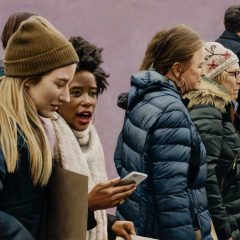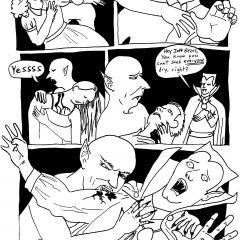[Elizabeth experiences Bushwick, Brooklyn’s recent art fair, highlighting works that stayed with her; she notes that a relaxed atmosphere is among the fair’s admirable accomplishments. — the Artblog editors]
I can’t stop repeating “Something for the weekend, sir?” and comparing Exchange Rates: The Bushwick Expo to a barbershop, since the free art exposition recalls a chummy, neighborhood business that encourages serious networking amidst fleeting, down-to-earth pleasures. Months in the making, the international art exposition, which took place from Oct. 23-26, was fruit of the collaboration between Centotto and Theodore: Art galleries from Brooklyn, and the London-based Sluice___ Art initiative. Over 30 international galleries were matched with 20 host galleries across Brooklyn.
Insouciant and inflammatory ideas
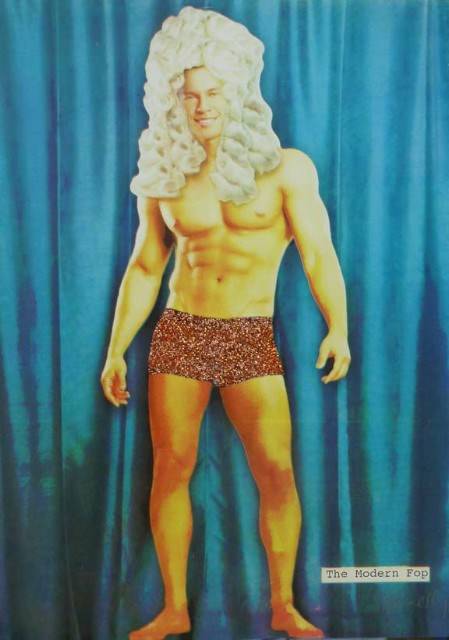
I lift “Something for the weekend, sir?” from the title of Sadie Hennessey and Julia Riddiough’s show sponsored by A Brooks Art, a clearinghouse for innovative, international collaborations based in London. The artists are quoting an average British barber; his tone is at once fulsome, mock-stylish and business-savvy, as it is his habit to offer clients rubbers from a hidden drawer after their shave or trim.
Repeating “Something for the weekend, sir?” conjures the spirit of Exchange Rates: The Bushwick Expo. For one weekend only, that voice breezes through time zones as freely as the smell of aftershave, and it claps an invisible hand on shoulders of artists and gallerists alike, initiating everyone as an insider.
Hosted by Fuchs Projects, the exhibition Something for the Weekend, Sir? features Riddiough’s video “Clip Cut Gel,” which invites the female gaze to linger and pan over stock images from male hairdressing magazines. The piece overlays three hair models with invented voiceovers, pretending to reveal the men’s lack of self-confidence and arrogance. The exercise playfully objectifies men, yet elicits sympathy for them, since Boy Toy’s got pimples, and Rough Trade and Play Boy seem to be a bit overly chiseled, posed and cleft of chin. I’m torn between laughing at and identifying with a guy who buys into beauty techniques; yet, I’m also attracted and wary of him. The work links feminism with humor mined from a lifetime of dating experience, and it puts the shoe on the other foot, so to speak, granting women access to male privacy and the secret world of barbershops.
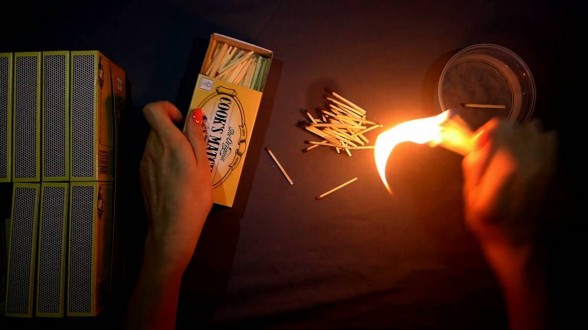
Co-founder of the Queen’s Park Railway Club in London, Leanne Hopper plays with identity and is currently working under the name Ellis Luxemburg. She previously shared the name Karen Elliot with numerous other artists, and says, “I’m happy for people to take on the character of Ellis Luxemburg if they find it helpful,” though it’s the tone of her voice in the video “Conventions” in the adjoining gallery at Fuchs Projects that grabs my attention. Quoting Internet sources about building bombs, and snippets of Walter Benjamin’s The Author as Producer, linking photography, revolution, and beauty, Leanne lights cooking matches grouped together, but the fire comes to nothing. She deletes select parts of her voiceover since she could be arrested for publishing bomb-making content. Frustrated effort, self-censorship, and the sense that resistance is futile mirror the recent thwarted vote for independence in Scotland, her native country.
Sussing out subtleties with Blackwater Polytechnic
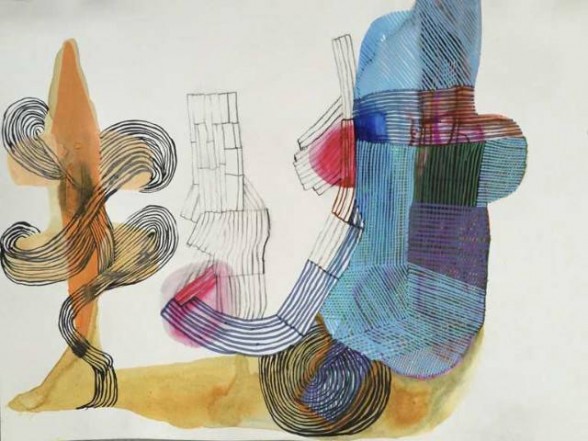
Art fairs generally drive me to cover ground, but at Exchange Rates, I chatted with everybody and barely moved. The party atmosphere invited less-guarded conversation about the work, and as these artists address issues that are exotic but still within parameters I’m familiar with, I found myself fine-tuned to the subtleties within recognizable styles.
At Theodore:Art, artist Ben Coode Adams described Blackwater Polytechnic, a utopian cooperative he runs with his wife, Freddie Robins, on the family farm in Essex, UK. His colorful watercolors evoke Henry Darger, but ease Darger further into abstraction, often employing Aboriginal-style patterns. Robins’ sock people with knitting-needle tails, Paula Kane’s mock-idyll paintings of an illusory arcadia, Sara Impey’s Barbara-Kruger-style text messages in thread and fabric, Justin Knopp’s striking prints built from found typeset pieces, and Simon Emery’s jazzy, car culture sculptures together engage almost every genre and material. Like a community of pagan Shakers, or a WiFi-enabled Arts and Crafts movement, the farm is a self-sustaining effort that fiercely supports only Essex artists, a band of makers that is proud to say: “We do our own thing and come together over shared kinship, and dirt, shooting, horses, cars, and bikes, heels, short skirts, fish pedicures, ale, and giant car-boot sales. We may look a bit like you. We are not you.”
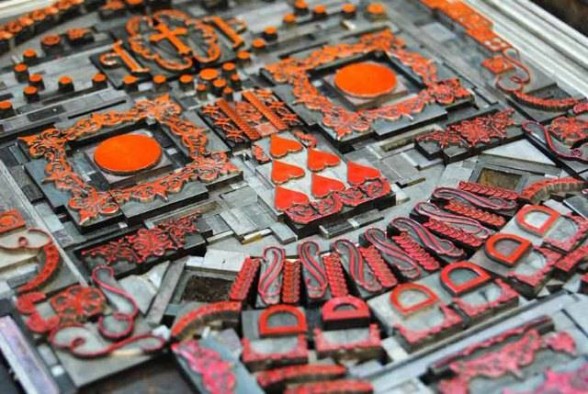
Tiny works with big impact
Elisa Bollazzi is the director of MicroCollection, a curatorial practice that rescues miniscule fragments shed by art shown in venerable, international exhibitions; the list of “works” collected is extensive and still growing. Reducing art collection to such a small scale effectively corrects overheated art-fair values through subtle personal intervention. During tea at Paul D’Agostino’s Centotto Salon, Elisa unfolds a piece of paper, showing me one of her tiny salvaged works as she reads three Italian poems that Paul has translated into English. “At First Sight,” “Magic,” and “The Encounter” describe the three stages of a love affair; columns of the words are arranged so that reading different directions yields different meanings, though the end is always tragic. Having no names, no concrete setting, and no time, the poems–in concert with a microscopic work– stimulated surprising feelings of loneliness.
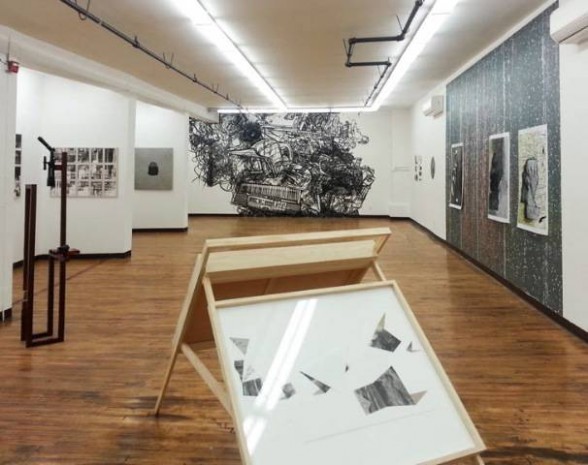
I finished my tour at Active Space, where Bushwick’s Associated Gallery, OUTLET, and Parallel Art Space are hosting Artist Proof Studio (printmakers from South Africa), and Telescope (Beijing) and FORT (London) galleries in Altered Terrain: this sprawling but well-organized show considers modern landscape as it ranges from the abstract to the realistic. Matthew Shelly’s folded paper sculptures, Heeseop Yoon’s giant, site-specific Mylar wall drawing, and Joshua Johnson’s erudite installations make high marks in forward thinking, setting me up to relish the lush, Albrect Durer-like linocuts by Johannesburg’s Jan Tshikhutula. I scan these potent renderings for historic or political references, seeking qualities that separate them from European tradition or define them as exclusively South African; yet I come up empty, and conscious that my expectation adds not a whit to Jan’s extraordinary vistas.
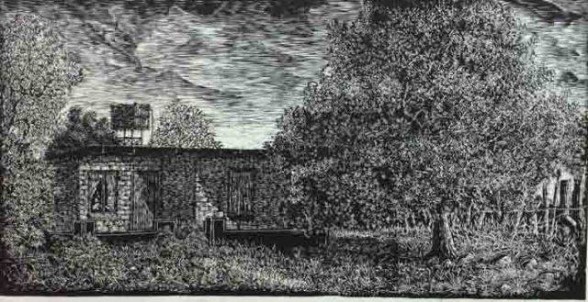
Bushwick, Brooklyn is becoming an art brand, and as the curation sharpens and the art on offer expands in scope, the low cost of expositions such as Exchange Rates: The Bushwick Expo are powering a slow but effective eclipse of international art fair models: most importantly, the I-have-a-friend-in-the-neighborhood, small business feeling of local art fairs remains intact.
Exchange Rates: The Bushwick Expo ran from Oct. 23-26 at various New York City locations.


